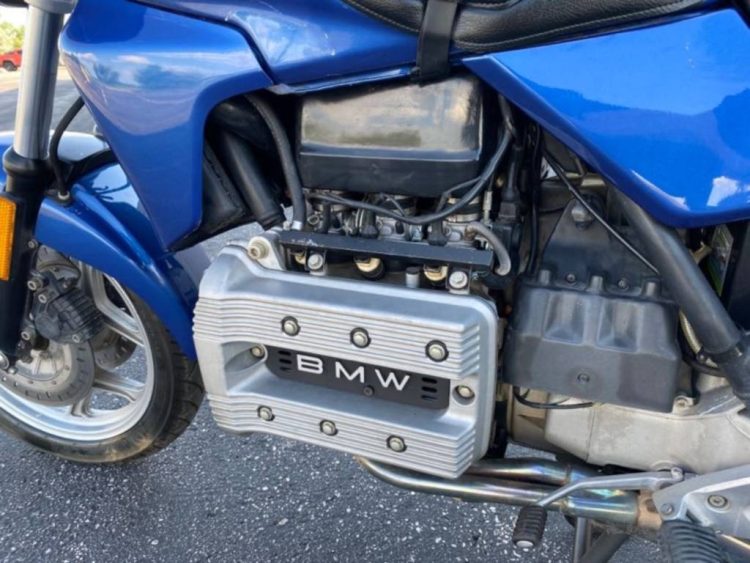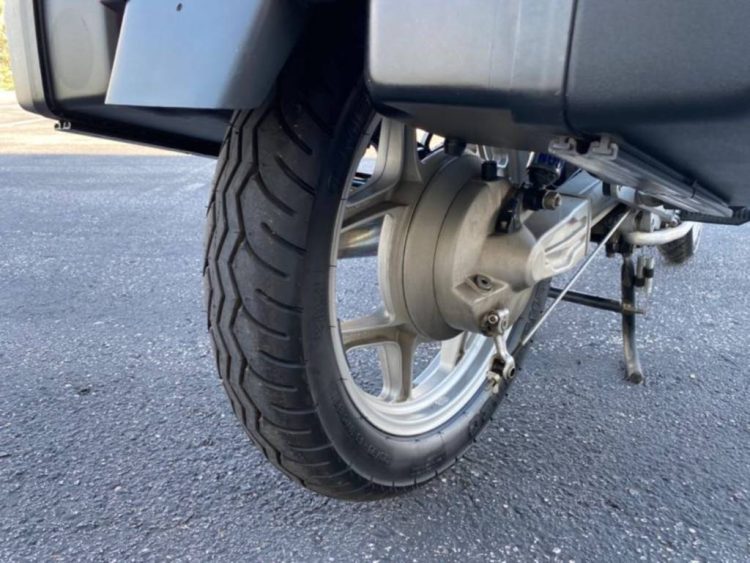It’s a vicious cycle. A manufacturer builds a motorcycle that’s reliable, but perhaps not terribly exciting. The market floods with these bikes and in a few years, they’re available on the cheap because they are unappreciated. They aren’t exactly classics, but their affordability, reliability and unique look endears them to the DIY custom bike crowd. In less than a decade, they’ve bought just about every example available on the used market, hacked it to bits, and now what was once a cheap, reliable ride is now only available as hyper-expensive restoration project, or as a half-finished “garage build.”
我看ed it happen to the Yamaha XS650 series (I, alas, was one of those “garage builders”). I watched it happen to Honda’s GL/CX line, and the SOHC four-cylinder series. And more recently, it happened to BMW K-bikes. That’s what makes this 1986 K75 C a bit of a rarity today—it hasn’t been cut apart into a bobber, and although it appears to be fairly original and unabused, the price tag isn’t out of reach.

The engine’s fiddly bits were mostly easy to access, and thankfully the K-series bikes didn’t need much fettling anyway. Photo: Mount Rushmore Motorsports
BMW’s past future
BMW’s initial K-bikes could be the most unappreciated motorcycles ever made in Europe. The K100 four-cylinder debuted in 1982 as a response to emissions regulations and tough competition from Japan, followed by the closely-related K75 triple in 1983. Objectively speaking, these were a vast improvement over the dated opposed-cylinder engines of the late, ’70s, but many of the airhead faithful hated them intensely, while the Japanophiles saw no reason to switch over from Honda/Suzuki/Kawasaki/Yamaha.
(Indeed, this was still the case 20 years later, as BMW tried to pull buyers from the Big Four’s performance bikes with the new K1200 R, sold under the slogan “You don’t need a hibachi to cook Japanese”).

Drum brakes? Sigh. At least there’s a cool single-sided swingarm. Later versions did come with a disc in back, and you can convert everything over if you’ve got the time and money. Photo: Mount Rushmore Motorsports
Looking back, the original K bikes did have a lot to like, even if they weren’t as fast as their counterparts from Japan. Basic maintenance was easy, with the cylinders tipped on their side and the heads hanging in the breeze. Fuel injection came standard, which was practically sci-fi stuff in the early 1980s. Later in the decade, ABS was also available as an option, another almost-unthinkable move at the time—these were the first production bikes with such a feature.
I remember the fun of testing this system on my cousin’s K75 C, avoiding a skunk in the middle of the road! My cousin bought his in the early ’00s, but it was practically brand-new; the fuel injection system was barely running, so it had never run up any miles. It had been imported to Canada via Japan, oddly enough, and we speculated that some Japanese owner, maybe even some factory skunk works program, had been tinkering with the EFI in some sort of forced induction experiment?

Liquid cooling, a heresy to airhead owners in the early 1980s! Photo: Mount Rushmore Motorsports
I also remember howsmooththis bike was. At that time, I and my riding friends had been bombing around on a collection of barely-running, much-abused Kawasakis and Yamahas and Hondas, and this almost-new BMW came with a perfectly-balanced 750 triple. It was a marked contrast, even if it came with funny switchgear (turn signal buttons on each handlebar) and a chassis that, if you pushed it too hard, would chuck you into a ditch or roadsign or oncoming traffic. My cousin came to grief aboard his K75 C (with thankfully no more damage than a cracked bikini fairing and a hole in the seat of his pants. While we never figured it out exactly, we suspected the bike’s handling was to blame, particularly when another cousin bought a K75 S and found the dreaded speed wobble that these bikes were known for.
The K75 today
BMW made a pile of these bikes from the 1980s through the early 1990s, and now many of those bikes are hitting the market at affordable prices because they’re getting old and worn out. A low-mileage version is a rare find. That’s what makes the bike in these photos, a 1986 C model, particularly interesting, with under 19,000 miles on the odometer. It also comes with what appears to be an OEM luggage package, which isn’t color-matched to the blue bodywork, but still looks right, and allows you to go for either a cafe racer or a sport touring look.
At $4,499, it’s expensive for a 38-year-old bike, but this machine could have decades of life left in it, with that low mileage.

The view from the cockpit. It’s like stepping into a time machine for me, as my cousin’s old ’86 C model looked the exact same. I’d say the original owner likely had a BMW tankbag to fit this bike as well, but that doesn’t seem to be included in the sale. Photo: Mount Rushmore Motorsports.
Or it could be a ticking time bomb. One problem with vintage K bikes is, if you need parts, they’re sometimes hard to find and/or expensive. Some stuff is easy, and BMW still has lots of parts in stock for these bikes, but if you need a final drive, it will set you backa lotof money, especially as many of the aftermarket repair/replacement options have disappeared.
So, if you want to buy a bike like this, your best bet is to maintain it with religious fervor, and don’t thrash it any harder than you have to. As a US-market machine, it will have the detuned 68-horsepower version of the engine, but you can no doubt figure out how to improve on that! But should you? On a machine like this, you’re not buying it for speed; you’re either buying it for its vintage enjoyability, or because you just want a reliable machine that you can trust. In either case, it’s probably best to leave it unmodified.

These cafe fairings had a brief run of popularity through the 1980s, and it’s a neat, period-correct look. Photo: Mount Rushmore Motorsports
See the bike’s listing at Mount Rushmore Motorsports in Rapid City, South Dakota,here.







